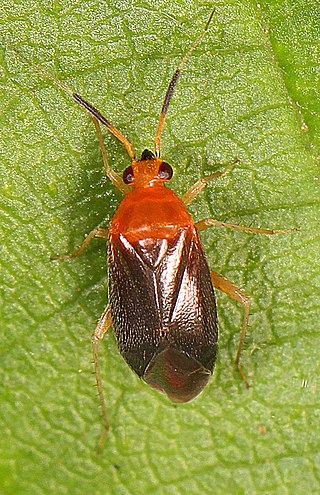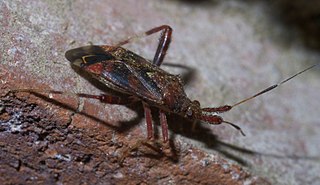
Anthocoridae is a family of bugs, commonly called minute pirate bugs or flower bugs. Worldwide there are 500-600 species.

Rhyparochrominae is a subfamily of dirt-colored seed bugs in the family Rhyparochromidae. There are more than 410 genera and 2,000 described species in Rhyparochrominae.
Blissus insularis, the southern chinch bug, is a species of true bug in the family Blissidae. It is found in North America and Oceania. The southern chinch bug is known to be a pest due to its feeding on St. Augustine grass.

Ceratocapsus is a genus of plant bugs in the family Miridae. There are more than 130 described species in Ceratocapsus.

Halticotoma is a genus of plant bugs in the family Miridae. There are about six described species in Halticotoma.
Caulotops is a genus of plant bugs in the family Miridae. There are about eight described species in Caulotops.

Hypochthonius is a genus of mites in the family Hypochthoniidae. There are about 10 described species in Hypochthonius.

Rhinocapsus is a genus of North American plant bugs in the family Miridae. There are at least two described species in Rhinocapsus.

Thyanta is a genus of stink bugs in the family Pentatomidae. There are about 19 described species in Thyanta.
Lasiochilus is a genus of true bugs in the subfamily Lasiochilinae and tribe Lasiochilini. There are about 17 described species in Lasiochilus.

Calochromus is a genus of net-winged beetles in the family Lycidae. There are at least 20 described species in Calochromus.
Gracilimiris is a genus of plant bugs in the family Miridae. There are at least three described species in Gracilimiris.
Barberiella is a genus of plant bugs in the family Miridae. There are at least two described species in Barberiella.

Pseudoxenetus is a genus of plant bugs in the family Miridae. It is monotypic, having only one described species, Pseudoxenetus regalis. The species is specialized to only feed on oaks.

Neurocolpus is a genus of plant bugs in the family Miridae. There are about 19 described species in Neurocolpus.

Psallus is a genus of plant bugs in the family Miridae. There are more than 170 described species in Psallus.

Americodema is a genus of plant bugs in the family Miridae. There are at least two described species in Americodema.

Megaloceroea is a genus of plant bugs in the family Miridae. There are at least three described species in Megaloceroea.

Cimolus is a genus of leaf-footed bugs in the family Coreidae. There are at least four described species in Cimolus.

Lasiochilus fusculus is a species of true bug in the family Lasiochilidae. It is found in the Caribbean Sea and North America.














